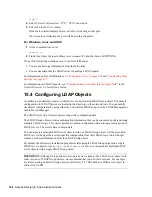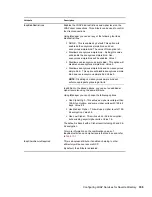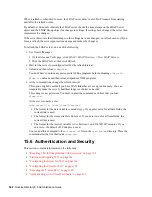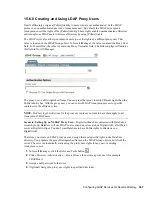
368
Novell eDirectory 8.8 Administration Guide
n
ov
do
cx (e
n)
22
Ju
n
e 20
09
5
Click
LDAP
>
LDAP Overview
>
View LDAP Groups
> the LDAP Group object.
6
In the
Proxy User
field, click the
Browse
button, browse to and select the LDAPProxy user,
then click
OK
.
15.6.9 Using SASL
Simple Authentication and Security Layer (SASL) is a mechanism for adding authentication support
and data security services to connection-based protocols through different mechanisms. It presents a
well-formed interface between the protocols and mechanisms. In addition, it provides a protocol for
securing subsequent protocol exchanges within a data security layer along with data integrity, data
confidentiality, and other services.
SASL is designed to allow new protocols to reuse the existing mechanisms without requiring
redesign of the mechanisms, and it also allows existing protocols to make use of new mechanisms
without the redesign of protocols. To use SASL, each protocol provides a method for identifying
which mechanism is to be used, a method for exchange of mechanism-specific server-challenges
and client-responses, and a method for communicating the outcome of the authentication exchange.
SASL mechanisms are named by strings, consisting of uppercase letters, digits, hyphens, and
underscores. SASL mechanism names must be registered with the Internet Assigned Numbers
Authority (IANA).
If a server supports the requested mechanism, it initiates an authentication protocol exchange. This
consists of a series of server challenges and client responses that are specific to the requested
mechanism. During the authentication protocol exchange, the mechanism performs authentication,
transmits an authorization identity from the client to server, and negotiates the use of a mechanism-
specific security layer. If the use of a security layer is agreed upon, then the mechanism must also
define or negotiate the maximum cipher-text buffer size that each side is able to receive.
The LDAP server supports the following mechanisms:
DIGEST-MD5
EXTERNAL
NMAS_LOGIN
GSSAPI
These mechanisms are installed on the server during an eDirectory installation or upgrade. However,
on Linux and UNIX, the nmasinst utility must be used to install the NMAS methods.
As specified above, the LDAP server queries SASL for the installed mechanisms when it gets its
configuration, and automatically supports whatever is installed. The LDAP server also reports the
current supported SASL mechanisms in its rootDSE by using the supportedSASLMechanisms
attribute. Because these are the registered mechanisms, the correct naming conventions must be
used to make use of them.
The LDAP bind protocol allows the client to use various SASL mechanisms for authentication.
When the application uses the LDAP bind API, it must choose either the simple bind and supply a
DN and password, or choose the SASL bind and supply the SASL mechanism name and the
associated SASL credentials required by the mechanism.
Summary of Contents for EDIRECTORY 8.8 SP5
Page 4: ...4 Novell eDirectory 8 8 Administration Guide novdocx en 22 June 2009...
Page 72: ...72 Novell eDirectory 8 8 Administration Guide novdocx en 22 June 2009...
Page 118: ...118 Novell eDirectory 8 8 Administration Guide novdocx en 22 June 2009...
Page 130: ...130 Novell eDirectory 8 8 Administration Guide novdocx en 22 June 2009...
Page 188: ...188 Novell eDirectory 8 8 Administration Guide novdocx en 22 June 2009...
Page 222: ...222 Novell eDirectory 8 8 Administration Guide novdocx en 22 June 2009...
Page 240: ...240 Novell eDirectory 8 8 Administration Guide novdocx en 22 June 2009...
Page 264: ...264 Novell eDirectory 8 8 Administration Guide novdocx en 22 June 2009...
Page 290: ...290 Novell eDirectory 8 8 Administration Guide novdocx en 22 June 2009...
Page 322: ...322 Novell eDirectory 8 8 Administration Guide novdocx en 22 June 2009...
Page 540: ...540 Novell eDirectory 8 8 Administration Guide novdocx en 22 June 2009...
Page 548: ...548 Novell eDirectory 8 8 Administration Guide novdocx en 22 June 2009...
Page 616: ...616 Novell eDirectory 8 8 Administration Guide novdocx en 22 June 2009...
















































